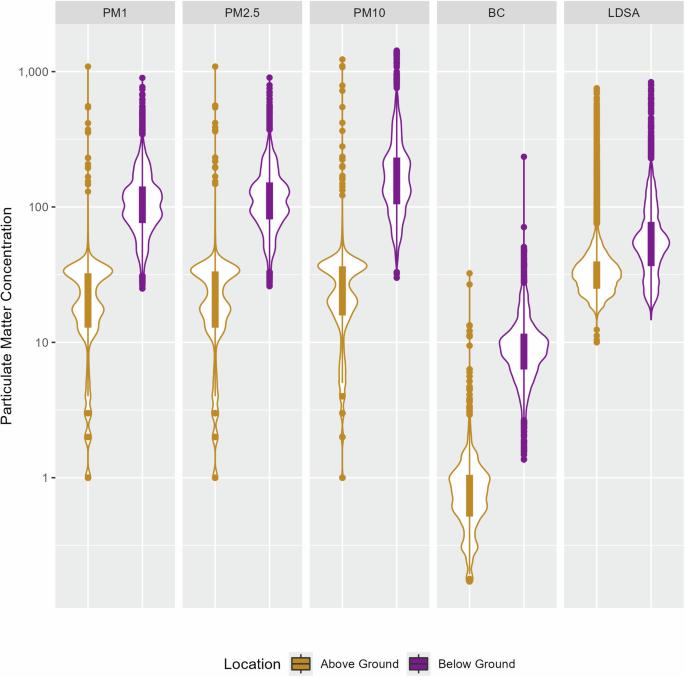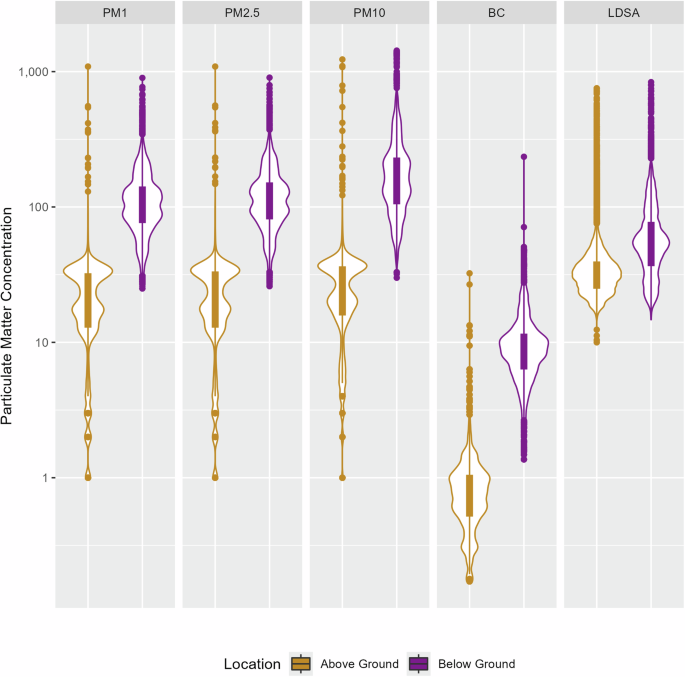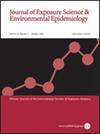Assessment of air quality in the Philadelphia, Pennsylvania subway
IF 4.7
3区 医学
Q2 ENVIRONMENTAL SCIENCES
Journal of Exposure Science and Environmental Epidemiology
Pub Date : 2024-08-14
DOI:10.1038/s41370-024-00711-9
引用次数: 0
Abstract
Subways are popular and efficient modes of transportation in cities. However, people are exposed to high levels of particulate matter (PM) in subways. Subway air quality in the United States has been investigated in a few cities, but data is lacking on simultaneous measurement of several pollutants, especially ultrafine particles (UFP) and black carbon (BC), in combination with different size fractions of PM. The goals of this study are to assess air quality in a belowground subway and compare it with outdoor ambient levels, to examine temporal variability of PM in the subway, and to analyze the correlation between PM and BC. Particulate matter of varying sizes (PM1, PM2.5, PM10), UFP, and BC were measured using DustTrak, nanoparticle detector, and micro aethalometer, respectively. Measurements were made at the belowground subway platform and the aboveground street level at 15th Street subway station in Philadelphia during summer 2022. Belowground mean PM1, PM2.5, and PM10 were 112.2 ± 61.3 µg/m3, 120 ± 65.5 µg/m3, and 182.1 ± 132 µg/m3, respectively, which were 5.4, 5.7, and 7.6 times higher than the respective aboveground street levels. The UFP lung deposited surface area (LDSA) (59.4 ± 36.2 µm2/cm3) and BC (9.5 ± 5.4 μg/m3) belowground were 1.7 times and 10.7 times higher than the aboveground. The pollutant concentration varied from day-to-day on both the locations. A higher positive correlation was found between the belowground BC and PM2.5 (r = 0.51, p < 0.05) compared to the aboveground (r = 0.16, p < 0.05). This study showed high levels of particulate matter exposure at a belowground subway station in Philadelphia. Particulate matter levels were about 5 to 8 times higher at belowground subway station than the corresponding aboveground street level. Higher levels were also observed for UFP lung deposited surface area (LDSA), while black carbon levels showed the highest concentration at the belowground level by a factor of ten compared to the aboveground level. The study shows the need for air quality management at belowground subways to reduce particulate matter exposure for the commuters.


宾夕法尼亚州费城地铁空气质量评估。
背景:地铁是城市中广受欢迎的高效交通方式。然而,人们在地铁中暴露在高浓度的颗粒物(PM)中。美国有几个城市对地铁空气质量进行了调查,但缺乏同时测量几种污染物,特别是超细颗粒物(UFP)和黑碳(BC)以及不同粒径的可吸入颗粒物的数据:本研究的目的是评估地下地铁的空气质量,并与室外环境水平进行比较,研究地铁中可吸入颗粒物的时间变化,分析可吸入颗粒物和黑碳之间的相关性:方法:分别使用 DustTrak、纳米粒子检测器和微压计测量了不同大小的颗粒物(PM1、PM2.5、PM10)、UFP 和 BC。测量于 2022 年夏季在费城第 15 街地铁站的地下地铁站台和地上街道层进行:地下的 PM1、PM2.5 和 PM10 平均值分别为 112.2 ± 61.3 µg/m3、120 ± 65.5 µg/m3和 182.1 ± 132 µg/m3,分别是地面街道水平的 5.4、5.7 和 7.6 倍。地下的肺沉积面积(59.4 ± 36.2 µm2/cm3)和 BC(9.5 ± 5.4 μg/m3)分别是地面的 1.7 倍和 10.7 倍。两个地点的污染物浓度每天都有变化。地下 BC 与 PM2.5 之间存在较高的正相关性(r = 0.51,p):这项研究表明,费城一个地下地铁站的颗粒物暴露水平很高。地下地铁站的颗粒物水平是地面街道水平的 5 到 8 倍。此外,还观察到 UFP 肺沉积表面积(LDSA)水平较高,而黑碳水平显示地下水平的浓度最高,是地上水平的 10 倍。这项研究表明,有必要对地下地铁进行空气质量管理,以减少乘客接触颗粒物的机会。
本文章由计算机程序翻译,如有差异,请以英文原文为准。
求助全文
约1分钟内获得全文
求助全文
来源期刊
CiteScore
8.90
自引率
6.70%
发文量
93
审稿时长
3 months
期刊介绍:
Journal of Exposure Science and Environmental Epidemiology (JESEE) aims to be the premier and authoritative source of information on advances in exposure science for professionals in a wide range of environmental and public health disciplines.
JESEE publishes original peer-reviewed research presenting significant advances in exposure science and exposure analysis, including development and application of the latest technologies for measuring exposures, and innovative computational approaches for translating novel data streams to characterize and predict exposures. The types of papers published in the research section of JESEE are original research articles, translation studies, and correspondence. Reported results should further understanding of the relationship between environmental exposure and human health, describe evaluated novel exposure science tools, or demonstrate potential of exposure science to enable decisions and actions that promote and protect human health.

 求助内容:
求助内容: 应助结果提醒方式:
应助结果提醒方式:


